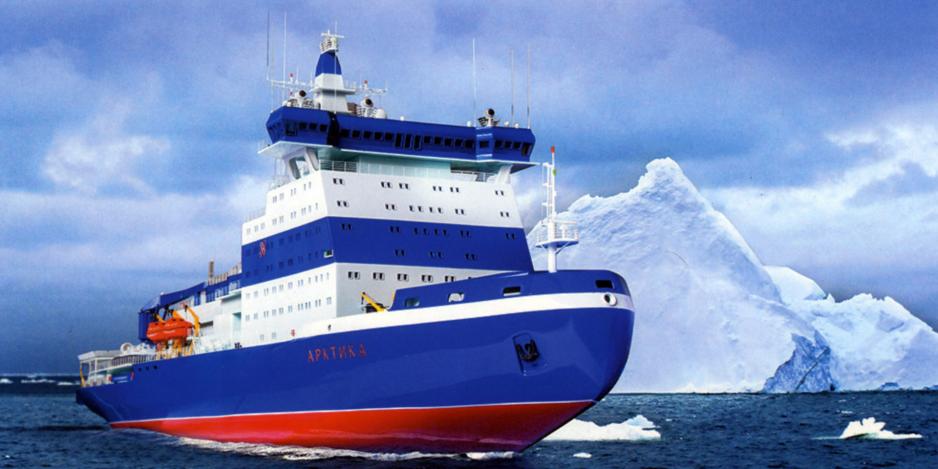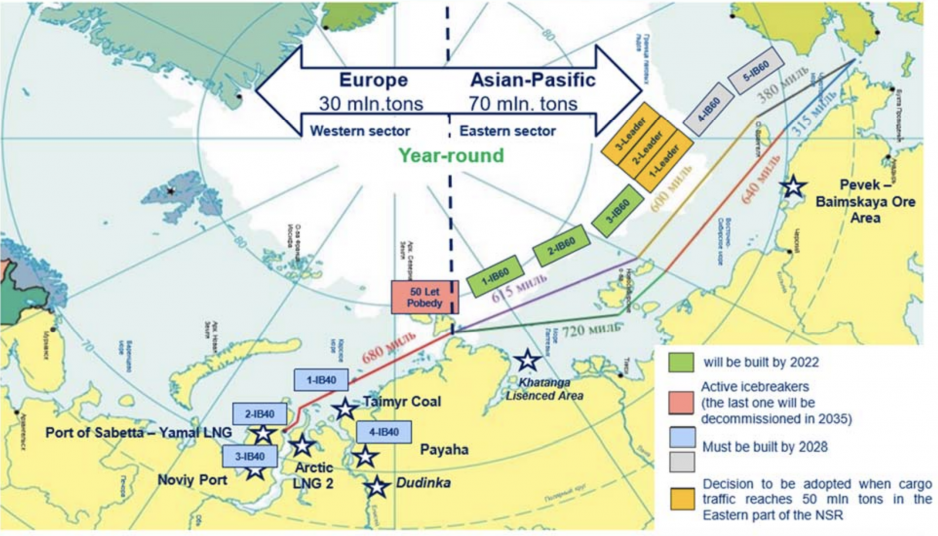Russia's Brand New Nuclear Icebreaker “Arktika” to Begin Sea Trials

Computer model of the Arktika icebreaker. (Source: Courtesy of Hanko on wikimedia under CC BY-SA 4.0)
Russia’s new flagship icebreaker Arktika nears commissioning heralding an era of modernized nuclear icebreaking capabilities. The country also launched the first vessel in a series of armed patrol icebreakers further expanding its military assets in the region.
Russia’s newest and largest nuclear icebreaker Arktika will begin sea trials on December 12, announced the constructing shipyard Baltiysky Zavod. The vessel represents the first in a series of five new icebreakers to be commissioned over the next few years. The vessel’s sister ships Sibir and Ural have also been launched, with a yet-to-be-named fourth and fifth vessel ordered in August 2019.
Sea trials will be conducted in the Gulf of Finland and will test the icebreaker’s propulsion system, communication and navigation equipment, and deck installations. Commissioning is expected for April 2020 at which point Rosatomflot, the country’s operator of all nuclear icebreakers, will take possession. The ship will operate in the Barents, Pechora and Kara Seas, as well as in shallow waters of the Yenisei estuary and Ob Bay.
“It is with the ships of this series of new-generation of icebreakers that we associate hope with the development of the Northern Sea Route. This is a fundamentally new ship,” explained Deputy Prime Minister Yury Borisov during the launch ceremony earlier this year.
Renewing the icebreaker fleet
The renewal of Russia’s aging icebreaker fleet is integral to the country’s goal to further expand shipping activity along the Northern Sea Route. Shipping traffic has grown ten-fold over the past decade expected to reach around 30 million tons in 2019. In recent weeks, the country’s Ministry for the Development of the Far East announced plans for a state-run liner service followed by news that Rosatomflot aims to launch container servicehttps://www.highnorthnews.com/en/rosatom-invest-7bn-arctic-shipping-compete-suez-canal between Europe and Asia as early as next year.
This new generation of icebreakers, referred to as Type LK-60Ya, represents the largest and most powerful icebreakers ever constructed and will replace the aging icebreakers of the original Arktika-class, of which only two Yamal and 50 Let Pobedy remain in service.
The icebreakers employ a variable draft design permitting them to operate in the deeper waters of the Arctic Ocean, but also in shallow coastal areas and rivers. The nuclear-turbo-electric propulsion generates more than 81,000 horsepower – nearly twice as much as the planned new U.S. icebreaker – enabling them to break through up to three meters of ice and travel on most of the NSR year round.
Overcoming delays and technical challenges
Russia launched the Aktika-class project in 2013 and originally expected to commission the first icebreaker by 2017. However technical challenges, including with the construction of a domestically-built steam turbine, resulted in a three-year delay. Sibir, the second vessel of the Arktika-class, scheduled for commissioning in 2021, underwent mooring trials last month during which the ship’s electrical system and main propulsion are tested for the first time while the ship is moored. The third vessel, Ural was launched earlier this year and should follow suit in 2022.
Keeping the NSR open year-round
With five LK-60Ya icebreakers, Rosatomflot will be able to maintain open shipping lanes and escort vessels along the NSR for the majority of the year. With the assistance of these icebreakers large stretches of the route will be accessible even during the winter months, except for part of the East Siberian Sea where difficult ice conditions frequently persist. For this purpose the state company has for a number of years considered commissioning an even larger class of icebreakers, the LK-100Ya, which would be able to ensure year-round navigation.
An investment decision for up to three icebreakers of this type is expected for the coming years. In a recent presentation Rosatomflot laid out details about how nuclear icebreakers would be positioned along the route, with the five LK-60ya operating in the western and far eastern parts of the route, while the LK-100Ya would cover the central section.

Planned Rosatom icebreaker fleet positioning by 2035 with 100 million tons of cargo. (Source: Courtesy of Rosatom)
Only for commercial use?
Aside from Rosatomflot’s unarmed nuclear icebreakers, Russia has also invested in armed conventional icebreakers for its military forces. In 2017 the Russian Navy commissioned the Ilya Muromets (Project 21180), its first icebreaker in almost 40 years. With a displacement of more than 6,000 tons it is the largest icebreaker ever built for the Navy.
Even larger icebreaking Arctic patrol ships (Project 23550) are currently under construction. The first vessel, the Ivan Papanin, was laid down in 2016 and launched in October 2019. The vessel’s armament includes cruise missiles and their size and capabilities are similar to Norway’s Svalbard-class.
Icebreakers, both those focused on commercial operations and those built for patrolling territorial waters and exclusive economic zone, are key to Russia’s interests in the Arctic. Rob Huebert associate professor at the University of Calgary and a senior research fellow with the Centre for Military and Strategic Studies explains that "icebreaker give them the capability to do what they want and how these assets are used really depends on what the political leadership wants to do with them. They will have much expanded capability, and the choice on how to use them remains with them."

